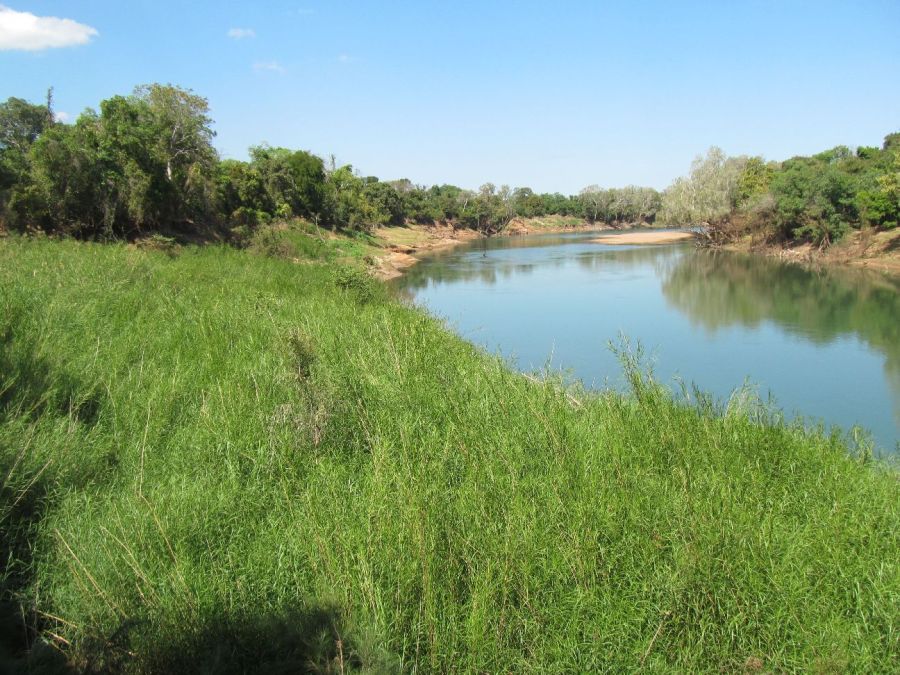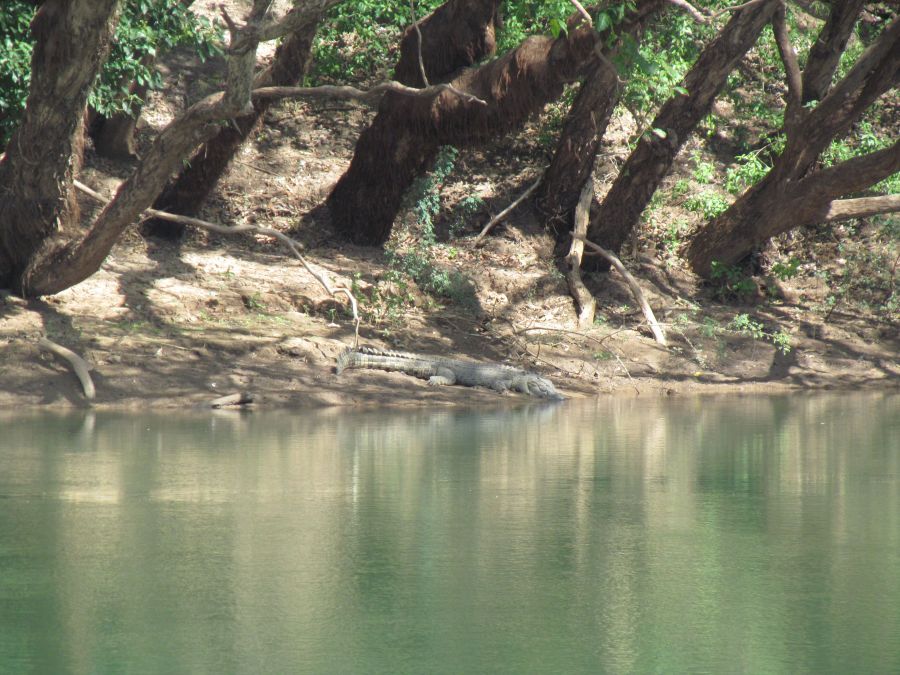Let me tell you story.
There once was a Bluetongue Lizard. He traveled around the great expanse of Australia forming rivers, mountains and lakes as he went along. He traveled many days and nights until one day he saw the outlines of trees on the horizon. He was very thirsty for he had eaten some strange mushrooms that had turned his tongue blue and parched his throat. He knew that the trees meant water and so he hurried towards the river, but when he got there…
What happens next? Do not worry, I will finish the story for you at the end of this post. For now, I’d like to tell you a little bit about what makes this tale special.
This story follows a style that is probably familiar to you. It may include some strange animals, but you recognize the general concept and structure: This must be a creation myth; a fairytale, maybe. A story told around the campfire.
And you are right. This is a part of an Australian Dreamtime narrative. These are the creation stories of Aboriginal Australians. They explain how the world was formed, why the sun sparkles on the water, why the Bluetongue Lizard’s tongue is, yes you guessed it, not red. They are an oral tradition, told over and over from generation to generation and thus passed on over millennia.
When is it Dreamtime?
For Indigenous Australians the Dreamtime is a time when the Ancestors, humans and animals alike, lived together on earth. Everyone had the ability to talk and each creature’s actions were able to alter the environment and their appearances. Wherever something significant happened, the Ancestors left their marks on the landscape: In the form of a rock, a river, an indestructible grove of trees. Where they met their end, they went into the ground and formed places of high significance. We might call them ‘sacred’ spaces. These have their own set of rules: For example, allow only women to enter, or give you a horrible rash if you collect pebbles from it.
Fred R. Myers explains it beautifully:
Frequently known as totemic ancestors in anthropological literature, the mythological personages of The Dreaming travelled from place to place, hunted, performed ceremony, fought and finally turned into stone or ”went into the ground”, where they remain. The actions of these powerful beings – animal, human and monster – created the world as it now exists. They gave it outward form, identity (a name), and internal structure. The desert is crisscrossed with their lines of travel, and, just as an animals tracks leave a record of what happened, the geography and special features of the land hills, creeks, salt lakes, trees are marks of the ancestors activities. Places where exceptionally significant events took place, where power was left behind, or where the ancestors went into the ground and still remain, are special sacred sites.

What makes a story a Dreamtime Story?
In many respects, these stories appear to be similar to familiar folktales and even biblical texts. To this day, people learn from and interpret these ancient tales to find meaning and significance in their lives.
However, there are some fundamental differences between the for us recognizable Western Stories and the Dreamtime Narratives. You see, I changed the structure of the story at beginning of this post for you. I altered it to give you a sense of familiarity. Even down to the phrases “There once was…one day he saw…”
But what if I told you that not everybody tells stories like this? That there are different ways to structure a story? That you wouldn’t be able to follow along as easily as here? Well, I am about to do just that.
Take a look at this translated excerpt from one of the first times I heard the Bluetongue Lizard’s story. A group of lovely Aboriginal ladies told it to me in MalakMalak, a highly endangered language spoken in the Daly River area of Northern Australia.
He (the Bluetongue Lizard) covered the mushrooms in ashes.
He went to eat the mushrooms.
He told the Goanna, “no! If you eat this food you will die! Only I (can eat it)”.
He ate it all by himself.
“I have to eat it” (he says).
He crawled around while eating.
The food has turned black.
The Bluetongue Lizard ate the mushrooms.
He ate them, finished.
He brought it (the food) along to here.
He walked from there.
He (the other Bluetongue Lizard) ran to the water and swam.
The King Brown Snake came looking for him (the Bluetongue Lizard).
He (the other Bluetongue Lizard) kept on swimming.
They both (the Bluetongue Lizard and the Goanna) now sit here forever.
“We turned into a dreaming” they say.
Confused? I know! I was when I first heard the story like this. I even now made it a little bit easier for you by identifying the different protagonists in brackets. Still, who is talking to whom? Are there two different Bluetongue Lizards? Two Goannas? Two different stories in one? Does the Lizard roast the mushrooms before he eats them or afterwards?

To be able to start to comprehend what is going on I had to listen to the story many many times over the next three years. Hear different versions, different angles, from different speakers. And finally, I think I understood. At least in part.
Everywhen
The Dreamtime Narratives of Australia are not told in chronological order. They are not told all at once. Over the course of a lifetime a member of an indigenous clan will hear varying versions of a story again and again until they might finally be able to piece together a complete story. The narrative structure follows conventions that are very different from what we are used to from fairytales and religious texts.
So how can we understand the Dreaming?
William Edward Hanley Stanner was an Australian anthropologist who shed light on the dismal treatment of Aboriginal peoples in modern Australia and brought their traditions and culture to a greater public awareness. He extensively studied the dreamtime narratives and coined the fascinating term “everywhen”.
“One cannot ‘fix’ The Dreaming in time: it was, and is, everywhen” W.E.H. Stanner
And with this simple term, the Dreamtime stories and their unfamiliar structure suddenly make more sense. These stories do not follow a clear trajectory in time. Instead they are organized around the space they are set in. The storyteller will narrate parts of the story organized around a single place. One such place might be the set for more than one episode within a dreamtime story. If that is the case, while telling the story, a speaker might switch effortlessly between episodes since they take place at the same spot without regards to temporal or episode organization. This is what happens in the small excerpt above. In the Bluetongue’s story it seems that two different lizards appear. One escapes the King Brown Snake’s fangs by crossing the river while the other forms an alliance with a Goanna and buries himself into its hole where he remains to form a sacred place. Consequently, the two storylines are told in a parallel fashion overlapping and intersecting with one another.
Additionally, it never becomes quite clear what happens at what time in the story. Are the mushrooms eaten before the Bluetongue gets to the river or after? What happens after one Lizard crosses the river? While the Goanna fights the Snake, is the Lizard already in the hole or still on its way to the river?
However strange this might seem: It actually doesn’t matter. The Dreaming, its actions and effects on the landscape are “everywhen”. They matter irrespective of their temporal succession. In fact, they cannot be ordered in time, because the Dreaming and its effects are omnipresent and cannot disappear in one place to occupy another.
“[For] Aboriginal people living in remote Aboriginal settlements, The Dreaming isn’t something that has been consigned to the past but is a lived daily reality” Jeannie Herbert Nungarrayi
What we can know is that Dreamtime narratives are the creation stories of indigenous Australians. They are deeply rooted in landscape and environmental features and create zigzagging ‘invisible’ pathways – Dreaming Tracks – all over the continent. Each section is assigned an “owner” who is responsible for re-telling the story in order to keep the connection between the land, its people, and animals strong. Most importantly, these stories cannot be forgotten. They are key to essential knowledge about the land; where to set up camp, where to find food, what to avoid doing.
But it is also important to know that
“We [non-Indigenous Australians] shall not understand The Dreaming fully except as a complex of meanings” W.E.H. Stanner
How does the Story end?
Well, I can only give you my best guess at it. A lifetime of study might not reveal every intricate detail and I won’t pursue this either. Even though I’ve somewhat tried.
When the Bluetongue Lizard reached the Daly River, he stumbled upon a King Brown Snake. The Snake was very cunning and lay there pretending to be sick. When the Bluetongue asked what was wrong, the Snake asked for a drink of water from the river. It wanted to gain the Lizard’s trust to be able to bite and eat him when he came back. The Lizard did not know how dangerous the Snake was and hurried towards the river. A Goanna had watched the exchange and came rushing out of its hole to tell the Lizard not to return to the devious Snake but to hide in the hole with him. The Lizard agreed and to this day he sits in the hole. Above him, thick cane grass grows along the river’s edge. Despite yearly flooding it returns without fail during the dry season, marking the Dreaming’s presence to this day.
As for the Snake, it waited and waited for the Lizard’s return and when a second unsuspecting Bluetongue came across him, he charged immediately chasing he other Lizard into the river. He crossed it frantically and the place where he emerged is marked today by a seasonal small growth of cane grass. The Snake could not follow into the water and the other Bluetongue moved onward on the opposite side of the river. This is when the Goanna emerged from the hole and fought of the Snake with special powers he gained from drinking a potion.

This is the story. Or it might not be. We may never know. All we really need to know is that the land is telling us these stories. It asks us to respect and protect it. It gives us insight into the oldest continuously surviving culture on earth. This knowledge is invaluable. We cannot let it disappear.

This is an excellent way to help us understand the dreamtime stories and how they crisscross through different parts of country and the stories then become a part of the intricate songlines of the Aboriginal People. Thanks so much. I teach Yorta Yorta Language as a L.O.T.E. in a Primary school in Shepparton and we have just finished writing our own stories. This is an excellent help that I will share with the kids.
Dear Annette, thank you so much for these kinds words and encouraging comments! I am very glad that these explanations might help the kids in Shepparton to understand their stories and history better! What an amazing feat to have written down the Yorta Yorta stories and to teach it as well! It makes me incredibly happy to see that the indigenous languages are not forgotten and remain strong or are “rediscovered” in so many areas of the country. There is still so much to learn. So much to understand.
[…] aim for regeneration and to help empower and create new speakers. Doro also explains a bit about dreamtime narratives in MalakMalak, which are traditional creation stories which, among other things, connect speakers […]